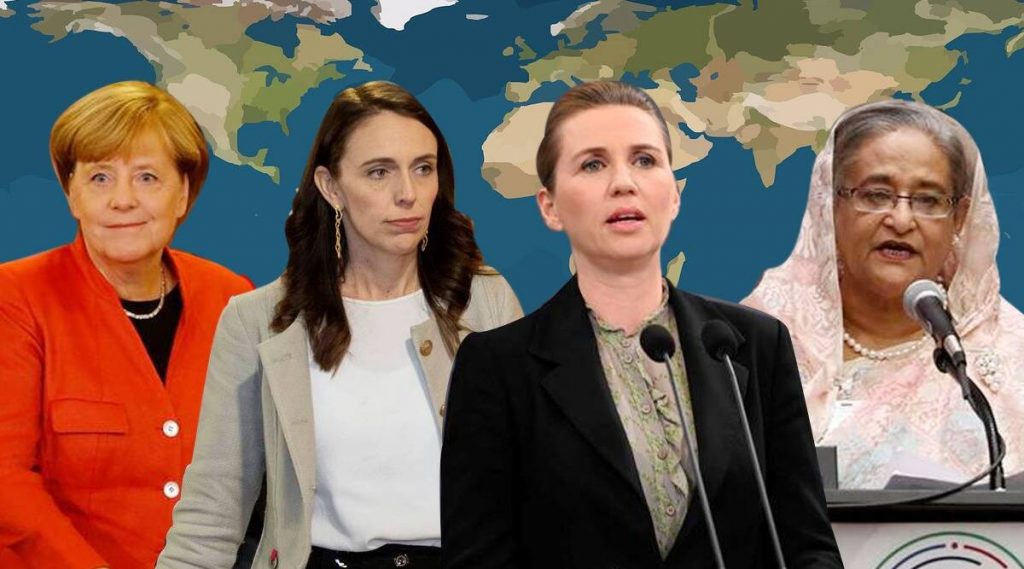Women Leaders: Are They Better for The World?

By Asad Mirza
In the on-going Covid crisis, the response by global women leaders has been more robust, pragmatic and effective as compared to men leaders.
The recent Covid pandemic has shown that the countries that were led by women leaders at the national level have better coped with the crisis. These countries also suffered half as many deaths as were averaged by countries led by men.
The success of Germany’s Angela Merkel, New Zealand’s Jacinda Ardern, Denmark’s Mette Frederiksen, Taiwan’s Tsai Ingwen and Finland’s Sanna Marin attracted many headlines but now a comparative analysis has been completed to show that the women leaders fared much better than their male counterparts.
Role of women leaders
A report published by the Centre for Economic Policy Research and the World Economic Forum based on the steps taken by leaders of 194 countries, concludes that the difference is real and ‘may be explained by the proactive and coordinated policy responses’ adopted by female leaders.
Supriya Garikipati, a developmental economist at Liverpool University and Uma Kambhampati of Reading University, the authors of the report, while speaking to The Guardian said, ‘Our results clearly indicate that women leaders reacted more quickly and decisively in the face of potential fatalities.’
They further said, ‘In all cases, they locked down earlier. While this may have longer-term economic implications, it has certainly helped these countries to save lives, as evidenced by the significantly lower number of deaths in these countries.’
Policy and strategy responses besides the number of Covid-19 cases and deaths until 19 May were taken into account to analyse the results along with other variables and reliable comparisons between different countries.
GDP, total population, population density and proportion of elderly residents, as well as annual health spending per head, openness to international travel and level of gender equality in society in general, were the different variables taken into account.
Global women leaders of the past
Till November 2019, 89 women leaders have graced the office of the prime minister or president in different countries around the world.
The first woman to be democratically elected as prime minister of a country was Sirimavo Bandaranaike of Sri Lanka, when she led her party to victory at the 1960 general elections and chartered a new path for asserting the Sinhala sentiment in the Sri Lankan politics.
The first woman to serve as president of a country was Isabel Martínez de Perón of Argentina, who as vice-president succeeded to the presidency in 1974. The first elected woman president of a country was Vigdís Finnbogadóttir of Iceland in 1980.
Included in the list is also Golda Meir, who was the fourth prime minister of Israel. The world’s fourth and Israel’s first and only woman to hold the office of prime minister, she was described as the ‘Iron Lady’ of Israeli politics; the term which was later applied to British prime minister Margaret Thatcher and Indian prime minister Indira Gandhi, also. Former Israeli prime minister David Ben-Gurion used to call Meir ‘the best man in the government’.
Then we have, Margaret Thatcher, the first woman to become prime minister of the UK. Her policies were referred to as ‘Thatcherism’, she was given the sobriquet ‘Iron Lady’, due to her uncompromising politics and leadership style. She led Britain to victory in the Falklands War and single-handedly broke the miners strike in 1984-85.
In Asia, we have many women leaders of tall stature, such as, Chandrika Kumaratunga, daughter of Srimavo Bandranaike, who graced the office as Sri Lanka’s first female President. She was able to handle the Tamil-issue in the island nation to a peaceful end after many setbacks.
In India, we had Indira Gandhi, who became the longest serving prime minister of the country. She led the country to a decisive victory in 1972 against Pakistan and was instrumental in the creation of Bangladesh. Gandhi remained a staunch supporter of the Palestinians in the Arab–Israeli conflict and was critical of the Middle East diplomacy sponsored by the United States. In 1999, BBC named her as the ‘Woman of the Millennium’ in an online poll. Time magazine also named her among world’s 100 powerful women who defined the last century.
Then we have Benazir Bhutto, who graced the office of country’s prime minster ship, twice, in Pakistan. Ideologically a liberal and a secularist, she chaired or co-chaired the Pakistan Peoples Party from the early 1980s until her assassination in 2007.
Then we have two warring ladies of Bangladesh, Khaleda Zia and Sheikh Hasina, both of whom served or are serving as the prime minister of the country. Forbes magazine ranked Khaleda at number 33 in the list of 100 Most Powerful Women in the World. On the other hand Sheikh Hasina was included in the list of
‘top 100 Global Thinkers’ of the present decade. Currently, she is a member of the Council of Women World Leaders, an international network of current and former female presidents and prime ministers.
Further in India, we have had 16 women serve as the chief minister of an Indian state or a union territory. Amongst them some of the stalwarts were Sucheta Kriplani, Anwara Taimur, Mehbooba Mufti, Mamta Banerejee, Jayaram Jayalalithaa and Mayawati. The last two served as the chief minister of Tamil Nadu and Uttar Pradesh. Both of whom are described as megalomaniac and assertive, but also credited with charting a new course in the Indian politics. PV Narasimha Rao, former prime minister of India, described Mayawati’s rise from humble beginnings as a ‘miracle of democracy’
So why are women leaders more successful?
So what are the reasons, which could be contributed to the success of these women leaders taking better decisions to handle the welfare of their citizens? Can we count pragmatism, more rationality and the women touch to be the pluses of their actions? Perhaps more research will shed more light on the attributable factors, but historically also we can say that these women leaders took their countries to newer heights due to their grit, dedication and the will to survive in a man’s world. Hats off to women power.
Urdu version of this article appeared in Daily Inquilab, 24 August 2020, Translation provided by the author.
Asad Mirza is a Sr journalist and commentator based in New Delhi. He writes on Muslims, educational, international affairs and interfaith issues. He can be contacted on asad.mirza.nd@gmail.com
